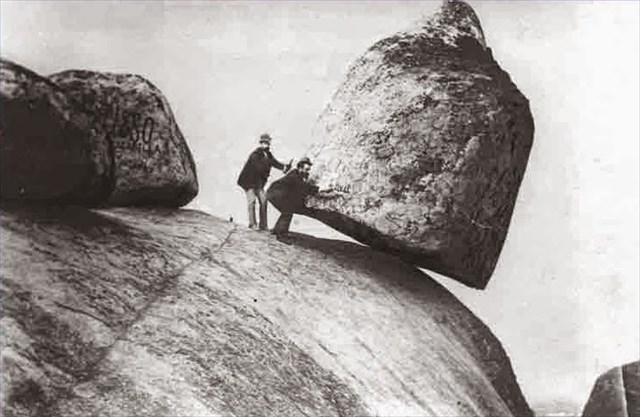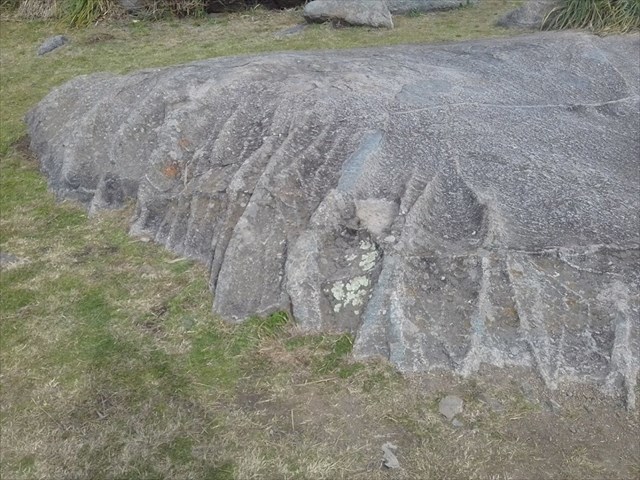Parque Lítico, La Movediza.
Las sierras de Tandil pertenecen al
macizo de Tandilia. Se formó geológicamente hace 2.500 millones de años. Está formado por rocas precámbricas tales como: granitos, dioritas, gneis, y por rocas paleozoicas como: cuarcitas y calizas, entre otras.
The mountain ranges of Tandil belong to the
Tandilia massif. It was formed geologically 2,500 million years ago. Precambrian tales as rocks formed by: granites, diorites, gneiss, and by Paleozoic rocks such as: quartzites and limestones, among others.
En las Sierras de Tandil es muy frecuente el notable fenómeno de la disyunción o exfoliación esferoidal de las rocas. Su núcleo se va descascarando progresivamente por acción química de las aguas, dando formas esferoidales. Su consecuencia es la característica formación de movedizas. La célebre Piedra Movediza de Tandil fue su máximo exponente. Cayó a causa del desgaste, el 29 de febrero de 1912, haciendo famosa a Tandil y, por ende, el Sistema tomó su nombre. Otra forma esferoide en transformación es la roca "El Centinela", que se encuentra emplazada a 9 km. al Sudoeste de la ciudad de Tandil. Pero muchas movedizas pueden ser observadas y, sobre todo, en antiguas canteras puede asistirse al curioso fenómeno formador de movedizas ya que, por meteorización, un bloque superficial se exfolia (descascara) y de esta manera, el núcleo esferoide, compacto, se desprende y rueda hasta el fondo, donde pueden verse reunidas un número importante de bochas.
In the Sierras de Tandil, the remarkable phenomenon of the disjunction or spheroid exfoliation of the rocks is very frequent. Its nucleus is progressively dehusked by the chemical action of the waters, giving spheroidal forms. Its consequence is the characteristic formation of shifting. The famous Movediza Stone of Tandil was its maximum exponent. It fell because of wear and tear, on February 29, 1912, making a famous Tandil and, therefore, the System took its name. Another spheroid shape in transformation is the rock "El Centinela", which is located 9 km. to the southwest of the city of Tandil. But many moved things can be observed and above all, in the old quarries can attend the curious phenomenon forming things that move, that weathering, a surface block exfoliates (shells) and in this way, the spheroidal nucleus, compact, it comes off and rolls to the bottom, where you can find an important number of bowls.

Las rocas que podemos ver en el parque, presentan distintos tamaños, pero la gran mayoría, poseen sus caras planas y redondeadas. Son un claro ejemplo de dos tipos de erosión, así, la cara que da al sudeste es cóncava y alisada con un marcado escape de vientos en su tercio superior, producto de la predominancia de estos, mientras que la opuesta, noroeste, es convexa y rugosa ya que su exposición al sol es mayor y la ausencia de vientos disminuyen notoriamente la erosión eólica, fenómeno que se conoce como "catafilar" o "cáscara de cebollas".
The rocks that we have in the park, have a lot, but the vast majority, their faces flat and rounded. They are a clear example of the types of erosion, thus, the face that faces the southeast is concave and raised with an escape of the winds in its upper third, product of the predominance of these, while the opposite, northwest, is convex and rugosa since its exposure to the greater sun and the absence of winds diminish notoriously the wind erosion, phenomenon that knows like "cataphyll" or "rind of onions".
El relieve de estas sierras está compuesto por granito, diorita y gneises.
The relief of these mountains is composed of granite, diorite and gneisses.
Granito
Es una roca ígnea muy dura, no calcárea, de aspecto cristalino y fácil pulimento, siendo la especie más amplia entre los minerales. El granito suele ser blanquecino o gris y con motas debidas a cristales más oscuros. El granito, junto a otras rocas cristalinas, constituye la base de las masas continentales y es la roca intrusiva más común entre las expuestas en la superficie terrestre.
Granite
It is a durable igneous rock, not calcareous, of crystalline aspect and easy polish, being the widest species among the minerals. The granite is usually whitish or gray and speckled due to darker crystals. The granite, together with other crystalline rocks, constitutes the base of the continental masses and is the most common intrusive rock among the rocks exposed on the earth's surface.
Diorita
La diorita es una roca ígnea compuesta de un feldespato y uno o varios minerales del grupo de la mica, de la anfibolita, y del piroxeno. Se usa generalmente para la construcción. Muestra una gran variabilidad de tamaños y formas más equidimensionales. Las dioritas son de extrema dureza. Es de textura granítica.
Diorite
The diorite is an igneous rock composed of a feldspar and one or more minerals from the mica group, the amphibolite, and the pyroxene. It is generally used for construction. It shows a great variability of sizes and more equidimensional shapes. The diorites are extremely hard. It has a granite texture.
Gneis
Se denomina gneis a una roca metamórfica compuesta por los mismos minerales que el granito (cuarzo, feldespato y mica) pero con orientación definida en bandas, con capas alternas de minerales claros y oscuros. A veces presenta concreciones feldespáticas distribuidas con regularidad, denominándose en este caso gneis ocelado.
Gneiss
Gneiss is a metamorphic rock composed of the same minerals as granite (quartz, feldspar and mica) but with a band selection, with alternating layers of light and dark minerals. Sometimes we present feldspathic concretions distributed regularly, denominating in this case ocellar gneiss.
Requisitos del registro: Envíame un mensaje privado con tus respuestas.
1.- Si bien en el Parque lítico podemos encontrar 3 tipos de rocas, Usted diría que predominan los granitos y dioritas? o los gneis? Cómo puede estar seguro de ello?
2.- En la zona, podemos ver algunas rocas emergentes, entre ellas una ubicada en las siguientes coordenadas: S 37° 18.530 W 059° 10.181
Esta roca llamará tu atención por su tamaño y por la forma en que se encuentra erosionada. Qué tipo de erosión sufrió?
Registration Requirements: Send me a private message with your answers.
1.- Although in the Lithic Park we can find 3 types of rocks, you would say that granites and diorites predominate? or the gneiss? How can you be sure of that?
2 .- In the area, we can see some emerging rocks, including one located at the following coordinates: S 37° 18.530 W 059° 10.181
This rock will attract your attention due to its size and the way it is eroded. What type of erosion did you suffer?

El concepto de este Earthcache es que el geocacher descubra este lugar increíble. Se puede profundizar más en el tema pero me gusta que este Earthcache sea breve y conciso, y que el visitante, se vaya habiendo aprendido algo nuevo. ¡Qué lo disfruten!
The concept of this Earthcache is that the geocacher discover this incredible place. I could explain more about the subject but I like my Earthcaches to be brief and concise so visitors leave the place having learned something new. Enjoy it!
Fuente: Fundació Càtedra Iberomericana - Graciela Nogar / Mercedes Baldoni / Valeria Capristo / Daniela Eizaguirre / Guillermina Jacinto / Marcela López

Bannercode:
<a href="https://coord.info/GC7WM4K" target="_blank"><img src="https://lh3.googleusercontent.com/-2mDik8CN5xw/W4lUKooJSsI/AAAAAAAAVg0/PY2BtDVPTeIIRu3tiUPCZ8IHJJ7E3w4OgCJoC/w220-h115-rw/ecmovediza.gif" alt="Movediza" title="Movediza"></a>
